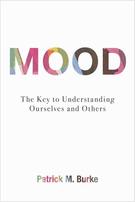Author(s): Patrick M. Burke, PhD
ISBN: 978-1-61614-833-1
APA Style Citation
Burke, Patrick (2014). MOOD: The Key to Understanding Ourselves and Others. New York: Prometheus Books.
| open_class_with_this_tomorrowmood_6.pdf |
Mood: The Key to Understanding Ourselves and Others is an excellent source of information related to motivation and emotion as well as mental illness and treatment. Published in 2014, Mood includes information which is aligned with the recently published DSM-5. Author Patrick Burke specifically describes not only the changes made to the DSM-5, but also the research behind the changes. The author provides a wealth of interesting and informative background information to help explain the nuances of the new diagnostic manual. Burke is an experienced child and adolescent psychiatrist whose clinical expertise suggests that biology, genetics, and relationships influence mood and as a consequence one’s world view.
This book examines the wide range of human emotion, especially with regard to mental illness, and how developmental and biological processes shape mood. Mood explicitly describes the various brain regions, neurotransmitters, and neural circuits related to mood. It also includes several helpful diagrams of brain regions and neural circuits. According to Burke, mood plays a central role in how individuals cope with life’s stresses and is a critical factor that determines whether a person will experience vulnerability to mental illness or resilience when exposed to difficult events.
Mood is divided into several chapters including the purposes of mood, human development and mood, the neuroscience of mood, and the impact of events on mood that are each relevant to a variety of units in an introductory psychology course. There are also six chapters addressing issues of mood in the context of mental illness and treatment that are especially useful with regards to explaining the research that shaped the organization of the DSM-5. Because moods are always present, the book highlights the difference between occasional mood related problems and mood related mental illnesses that may require treatment. There are separate chapters on anxiety disorders (When Moods are Worried and Fearful), bipolar and related disorders (When Moods are High or Low), and disruptive behaviors (When Mood is Indifferent). Each of the chapters related to mood and mental illness includes case studies, detailed explanations of DSM-5 classification, symptoms, and biological and environmental contributors. The book emphasizes the impact of neurotransmitters, hormones and neural circuits on moods, especially with regards to mental illness and how psychotropic medications are used to treat these conditions.
The sections on treatment provide detailed overviews of the major current therapies related to disturbances in mood including biomedical therapy, psychodynamic therapy (interpersonal psychotherapy IPT), cognitive behavioral therapy (CBT), psychosocial approaches, and other methods that are less likely to be discussed in introductory psychology textbooks. For example, the author discusses well-being therapy which was developed to increase levels of resilience in patients and is related to research on positive psychology. This treatment emphasizes building skills and resiliency that will inoculate individuals against developing symptoms in response to stressful events. A detailed and easily readable chapter regarding the major classes of medications used in the treatment of mood related mental illnesses explains how these medications work at the neural level.
Mood: The Key to Understanding Ourselves and Others provides excellent up to date information about how researchers understand mood and how it develops over the lifespan. The text highlights how a combination of genetic, neurological, and environmental factors combine to create moods and shape behavior. The inclusion of numerous case studies illustrating a variety of mental illnesses including antisocial personality disorder, depression, bipolar, generalized anxiety disorder, PTSD, and obsessive compulsive disorder make this book especially useful for psychology teachers and students of psychology.
Other Related Resources
American Psychiatric Association document highlighting the changes from the DSM-IV-TR to the DSM-5.
http://www.dsm5.org/Documents/changes%20from%20dsm-iv-tr%20to%20dsm-5.pdf
Ted ideas article addressing important topics in the area of mental health including ending stigma, avoiding correlations between criminality and mental illness, investigating the correlation between mental illness and suicide, and the impact of stigmatizing language.
TED ideas: How Should We Talk About Mental Health
http://ideas.ted.com/2013/12/18/how-should-we-talk-about-mental-health/
Psychological Figures and Concepts
Antisocial personality disorder
Anxiety disorders (e.g., generalized anxiety disorder, phobias, agoraphobia, panic)
Attachment (e.g., stranger anxiety, separation anxiety, parenting styles, John Bowlby)
Attention deficit hyperactivity disorder (ADHD)
Autonomic nervous system
Bipolar and related disorders (e.g., bipolar I, bipolar II, cyclothymia)
Brain regions (e.g., cortex, prefrontal cortex, insula, amygdala, thalamus, hypothalamus, hippocampus, nucleus accumbens, limbic system)
Circadian rhythms
Comorbidity
Conduct disorder/ Oppositional defiant disorder
Cortisol
Depressive disorders (e.g., major depression, persistent depressive disorder, disruptive mood dysregulation disorder)
Diagnostic and Statistical Manual of Mental Disorders (DSM-5)
Diathesis stress model
Epigenetics
fMRI
Fight-or-flight response
Gene and environment interaction
Heritability
Neural circuits (e.g., fear, reward, decision making, executive action)
Neurotransmitters (e.g. dopamine, GABA, serotonin, norepinephrine)
Obsessive compulsive and related disorders (e.g., OCD, hoarding)
Plasticity
Psychopharmacology (e.g. antianxiety, antidepressant, antipsychotic, mood stabilizers)
Psychotherapy (e.g. psychodynamic, cognitive-behavioral, IPT, well-being therapy)
Resilience and vulnerability
Social learning theory
Stress response system
Temperament
Trauma- and stressor-related disorders (e.g., acute stress disorder, posttraumatic stress disorder)

 RSS Feed
RSS Feed